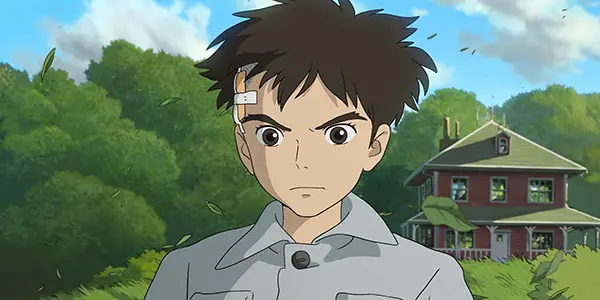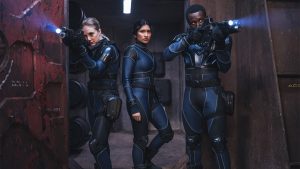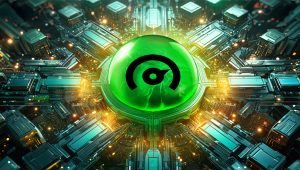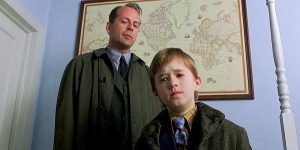
It begins with an inferno. Air raid alarms wail against the cry of panicked people, fleeing for their lives, abandoning homes and hope. A boy on the precipice between childhood and teenage years awakens in a panic, rushes to dress and, against his father’s wishes, braves the blaze in the streets in an attempt to save his beloved mother, to no avail. Flash forward, that same youth, suddenly thrust into growing up too fast and struggling to come to terms with his fate, is embarking on another life in an elegant, sprawling mansion in the peaceful countryside with his father, new stepmother, and other individuals and experiences that blur the lines between fantasy and reality. Thus commences The Boy and the Heron.
The boy is Mahito Maki (voiced by Soma Santoki and Luca Padovan in the English dub), who arrives from a torn-apart Tokyo to a rural Japanese town where his cold and formidable father, Shoichi (Takuya Kimura and Christian Bale, in English) is often absent and working. At the same time, his son deals with adjusting to a new life in a vast estate and new community with his fragile, pregnant stepmother Natsuko (who is also his late mother’s younger sister, voiced by Yoshino Kimura and Gemma Chan), being fussed over by a hoard of friendly and quirky busybody grannies, and encountering strange creatures who haunt his dreams and waking life, especially a mischievous grey heron who taunts him.
Feelings of overwhelming grief are teamed with alienation, anger, loneliness and the emotional landscapes of youth. Mahito hurts himself to express the pain and further isolate. He bears the scar as an outward reflection of inner turmoil. The adventure truly begins when the relentless gray “heron man” (Masaki Suda, Robert Pattinson in the English version) lures Mahito into the forbidden zones of the estate with the promise of seeing his mother, trapping and transporting him to another realm where life and death coexist.
In this warped simulacrum universe, legions of power-hungry parakeets dominate, a girl called Lady Himi (AIMYON and Karen Fukuhaka) controls fire, and curious creatures called the Warawara, little souls representing those passed or yet to be born are fed fish guts by a woman named Kiriko (Ko Shibasaki and Florence Pugh), who also protects them from the pelicans who see them as sustenance. With his new friends, the “frienemy” heron man, and adversaries who’d have him for lunch, Mahito delves deeper into the strange world, searching for his mother. He explores its mysteries and meets the elusive Granduncle, a distant relation rumored to have vanished after losing his mind from reading too many books. Granduncle (Shoehei Hino and Mark Hamill in the English dub), who presides over this place and maintains its balance, has wisdom and requests to impart upon his young kinsman.
Out of Retirement: From Struggle to Inspiration to Manifestation
Now widely released in theaters, garnering award nominations and debuting number one at the box office, the highly anticipated animated film was shown at an exclusive preview screening on November 17 at Japan Society, following its sold-out U.S. premiere at the New York Film Festival. Japan Society has developed a strong relationship with GKIDS, the distributor responsible for sharing films from Studio Ghibli and other treasures of Japanese animation with U.S. audiences, including Blue Giant, featuring the music of Hiromi, also screened at Japan Society. These special screenings are largely due to the passionate persuasion and long-standing relationships fostered by Peter Tatara, Japan Society Director of Film, who called The Boy and the Heron “Complex and compelling” and proclaimed, “We could not be more proud and humbled to present Miyazaki’s latest film. A deeply personal film, a profound semi-autobiographical fantasy, and it is nothing short of an opus from a master artist pouring himself on screen.” But the film was born from fighting with oneself and finally relenting to the calling of destiny.
source: Toho
The Boy and the Heron is the first feature film in ten years written and directed by Studio Ghibli’s co-founder, Japanese animation national treasure and the “Walt Disney of Japan,” Hayo Miyazaki, since the Academy Award nominated The Wind Rises. It was that time, following the film’s release in 2013 when Miyazaki publicly announced his retirement at age seventy-two. But the prolific visionary known equally for his brilliance as he is for his curmudgeonly nature and stoic perfectionism was not meant to take up golfing or relax at a retirement village in his autumn years.
Age has ceased slowing him down, though it has made him more reflective. A few years after declaring his retirement, Miyazaki announced he was back again, initially to plunge into a medium he’d previously shown intense disdain for — CGI — in a short film entitled Boro the Caterpillar, which set into motion a series of events and experiences (explored in the documentary Never-Ending Man: Hayo Miyazaki, released by GKIDS for the U.S. market in December 2018, which I reviewed for Anime News Network). His short foray into CGI led to an epiphany — “I feel the end of the world is near. Humans have lost confidence. Hand-drawing is the only answer. I won’t run from it anymore.”
So, along with his long-time colleague, Studio Ghibli general manager and producer Toshio Suzuki, Miyazaki embarked on his next feature film, an original story inspired by Genzaburō Yoshino’s 1937 novel “Kimitachi wa Do Ikiruka” (literally translated to “How do you live?”), about the spiritual journey of a fifteen-year-old boy after his father’s death, intermixed with autobiographical elements from Miyazaki’s memories of post-war Japan. Possessing all of the magic, wonder, and depth of previous Ghibli films, The Boy and the Heron is most likely Miyazaki’s final swan song, or “heron song,” in this case.
The Magical World of Miyazaki’s Mind
Fans of Studio Ghibli and Miyazaki’s vast contributions to exquisite, hand-drawn animation and imaginative, heartfelt stories will recognize elements of My Neighbor Totoro, Spirited Away, and other favorites that intersect the human and spirit world. There are also echoes of his more serious, challenging works about families enduring the suffering of war, like Grave of the Fireflies. Essentially, The Boy and the Heron is an amalgamation of all Miyazaki-led Studio Ghibli films and something that stands entirely on its own. Like Granduncle, Miyazaki is the creator of these realms and uses his memories, symbologies, imagination, and observations of the world and human nature as his building blocks.
source: Toho
Other familiar components are the charming aspects one comes to expect; the seriousness is softened with humor in the form of hoards of kind, protective and hysterical grannies, outrageous personalities driven by opportunistic intents of the heron man and the parakeets, whose character design alone is hilarious. Additionally, the story doesn’t shy away from the messy side of bird behavior but leans fully into it; their defecations are used as artillery! The parakeets represent the masses and a “mob mentality.” Their intense disdain for outsiders and oppressive, militant need for control and power is recognizable in dictatorships and those who separate “us and them.” Interestingly, parakeets have been known to be an invasive species. A few kept as pets are released or escape, and suddenly, whole swaths of Hampstead Heath in London or Northern New Jersey are overrun by squawking green birds!
Multilayered and full of meaning, the film is a deep dive into examining the disposition of humans and their spirit or animal counterparts from a greater-picture perspective. There are no absolute villains or victims, none who are portrayed as purely innocent or fully wicked. The characters are layered and dimensional; they are flawed, but each possesses the potential to evolve. The heron man is a trickster, lying and manipulative, motivated by selfish desires, but he becomes a friend in the end. Mahito closes himself off from others, trapped in his own mind, overwhelmed by incomprehensible feelings; he isolates and hardens his heart. But his hero’s journey softens that callus as he makes friends, overcomes challenges, opens his perceptions and allows others in. He returns to reality renewed. There is a pervasive sense of bravery in Miyazaki’s leading characters that is not innate but unfolds. The Boy and the Heron is a coming-of-age tale of a boy becoming a man.
Studio Ghibli’s long-time collaborator composer Hisaishi’s glittering, twinkling piano chords punctuate the emotion. The score is one of his most beautiful, stirring, and elegant. It’s simple in execution, complex in meaning, potent and intense with feeling. The moody piano sets the emotional tone for the film’s characters and most poignant moments. With a few exceptions of bold intensity, made all the more powerful by the contrast, the music and the story have a slower pace: unhurried, reflective, meditative, wandering, but not meandering. Neither Hisaishi nor Miyazaki have anything to prove. They can take their time and trust their message and meaning will be heard.
source: Toho
In the magical parallel universe, some mystical themes and aspects reflect Buddhist principles and philosophies or allude to Shintoism (an ancient Japanese religion focused on the importance of purity, harmony, respect for nature and family, and putting the group before the individual). The Warawara (Japanese for “laugh laugh”) are souls yet to be born, evoking life cycles — birth, death, and rebirth. Mahito confronts his fate (destiny), karma (what he’s put into the world, past or present and how it affects his future), dharma (“right action”), and “doors” to choose. When he meets Granduncle, he’s encouraged to take the stones, stack and order them, and “build your own world, free of malice.” Mahito admits he is not free from malice due to the harm he’s caused himself and others. However, he can change that; he’s gained the wisdom and accountability to see the error in his ways. It’s been stated that Miyazaki made this film for his grandson, passing the torch to the next generation to bring light to the world the way they see fit.
A Deeply Personal Yet Universal and Timely Tale
The film is both historical and deeply personal in a way that will resonate with those who have been through similar experiences. Certain events from Miyazaki’s childhood are depicted in animation for the first time—visions of Japan’s past that still vividly exist in Miyazaki’s memories. This makes me think of my Japanese father-in-law. Born in 1940, he’s a contemporary of Miyazaki and remembers witnessing the war unravel, and the landscape of Japan alter drastically overnight, as observed through the eyes of a five-year-old child. From the Chiba prefecture, in a rural town a couple of hours from Tokyo, he saw his people and culture uprooted. For him, the grounding force was food. His restauranteur family fed the village like royalty when rations were slight. He struggled with anger and resentment toward the American invaders, but as he matured, those feelings were transmuted into a deep desire to share his culture and connect over cuisine.
That impetus brought his family to America. Once there, his son, my partner, felt the alienation and isolation as Mahito did in a new community. He, too, transformed those feelings of separateness into a desire to use culture to foster understanding and appreciation. His focus was Japanese anime.
What Stories Will Be Told Next?
The horrors of war, violence, and the aftermath remind one of today’s global conflicts and the many individuals, families, entire generations, nations, and cultures affected. There are no winners in war; everyone suffers. A saying attributed to Confucius: “He who seeks revenge digs two graves.” The Boy and the Heron’s animated visions of a decades-old conflict feel painfully contemporary. It’s almost too much to bear at times, but this story is about the ability to face unbelievable circumstances and overcome them, finding strength and community amid chaos.
Survivors bear scars and recollections that linger, even if they cannot be seen. Miyazaki is a survivor, and like many in his generation, he still retains vivid memories of wartime Japan. It has shaped who he is, what he does, and the stories he shares with the world. Like many survivors of war, violence, and trauma, his stories are marked with the resilience of the human spirit, a deep longing for connection, bravery, and heroism in the face of extraordinary challenges, and a sense of hope and redemption against all odds.
Is The Boy and the Heron okay for kids? That depends. Today’s generation of children are exposed to more death and destruction at a young age from the news and other sources. It’s hard for a protective parent to shield them from that, so they might as well give them a safe space in an enchanting, fanciful setting to explore those difficult themes and life lessons. Psychiatrists recommend teaching empathy to children early on as one of the best ways to avoid narcissism from developing. Perhaps by watching the characters experience intense obstacles and overwhelming feelings, kids will learn to empathize, recognize the power of kindness, bravery and resilience, and understand the ability to grow, gain insights, and feel compassion for others.
What will the stories of today’s children who have witnessed the unimaginable be? Will they one day be able to see past the anger, grief, and pain to share timeless, unifying tales of heroic undertakings, overcoming insurmountable odds and the extraordinary resilience of the human spirit? How will they build their worlds, stone by stone, free of malice? Who are the next generation of Miyazakis, and how will they inspire us to be kinder to ourselves and others?
The Boy and the Heron has been in wide theatrical release in the U.S. since December 8, 2023, in Japanese with English subtitles and in an English dubbed version distributed by GKIDS.
Does content like this matter to you?
Become a Member and support film journalism. Unlock access to all of Film Inquiry`s great articles. Join a community of like-minded readers who are passionate about cinema – get access to our private members Network, give back to independent filmmakers, and more.






